A New Sensory Approach Combined with a Text-Mining Tool to Create a Sensory Lexicon and Profile of Monovarietal Apple Juices
Abstract
1. Introduction
2. Materials and Methods
2.1. Physicochemical Parameters and Colorimetric Analysis
2.2. The Text-Mining Tool and the Wheel Development
2.3. Sensorial Analysis
2.4. Statistical Analysis
3. Results and Discussion
3.1. Physicochemical Parameters and Colorimetric Analysis
3.2. The Wheel Development
3.3. Projective Mapping (PM) and Ultra-Flash Profile (UFP) Characterization
4. Conclusions
Supplementary Materials
Author Contributions
Funding
Acknowledgments
Conflicts of Interest
References
- Zaynutdinova, N.; Palka, P. The Effects on Purchase Intention: The Case of Fruit Juice. J. Compet. 2017, 9, 111–128. [Google Scholar] [CrossRef]
- Stolzenbach, S.; Bredie, W.L.P.; Christensen, R.H.B.; Byrne, D.V. Impact of product information and repeated exposure on consumer liking, sensory perception and concept associations of local apple juice. Food Res. Int. 2013, 52, 91–98. [Google Scholar] [CrossRef]
- Binkley, J.; Eales, J.; Jekanowski, M.; Dooley, R. Competitive behavior of national brands: The case of orange juice. Agribusiness 2001, 17, 139–160. [Google Scholar] [CrossRef]
- Delpino-Rius, A.; Eras, J.; Marsol-Vall, A.; Vilaró, F.; Balcells, M.; Canela-Garayoa, R. Ultra performance liquid chromatography analysis to study the changes in the carotenoid profile of commercial monovarietal fruit juices. J. Chromatogr. 2014, 1331, 90–99. [Google Scholar] [CrossRef] [PubMed]
- Jaros, D.; Thamke, I.; Raddatz, H.; Rohm, H. Single-cultivar cloudy juice made from table apples: An attempt to identify the driving force for sensory preference. Eur. Food Res. Technol. 2009, 229, 51–61. [Google Scholar] [CrossRef]
- Albert, A.; Varela, P.; Salvador, A.; Hough, G.; Fiszman, S. Overcoming the issues in the sensory description of hot served food with a complex texture. Application of QDA®, flash profiling and projective mapping using panels with different degrees of training. Food Qual. Prefer. 2011, 22, 463–473. [Google Scholar] [CrossRef]
- Valentin, D.; Chollet, S.; Lelièvre, M.; Abdi, H. Quick and dirty but still pretty good: A review of new descriptive methods in food science. Int. J. Food Sci. Technol. 2012, 47, 1563–1578. [Google Scholar] [CrossRef]
- Cliff, M.C.; Katarine, W.; Barb, J.E.; King, M.C. Development of a vocabulary for profiling apple juices. J. Food Qual. 2000, 23, 73–86. [Google Scholar] [CrossRef]
- Almeida, D.P.F.; Gomes, M.H. Physicochemical quality, macronutrients, and dietary fiber in apples from the protected geographical indication ‘Maçã de Alcobaça’, Portugal. Eur. J. Hortic. Sci. 2017, 82, 239–243. [Google Scholar] [CrossRef]
- Harker, F.R.; Marsh, K.B.; Young, H.; Murray, S.H.; Gunson, F.A.; Walker, S.B. Sensory interpretation of instrumental measurements 2: Sweet and acid taste of apple fruit. Postharvest Biol. Technol. 2002, 24, 241–250. [Google Scholar] [CrossRef]
- Pathare, P.B.; Opara, U.L.; Al-Said, F.A.-J. Colour Measurement and Analysis in Fresh and Processed Foods: A Review. Food Bioprocess Technol. 2013, 6, 36–60. [Google Scholar] [CrossRef]
- Onsekizoglu, P. Production of high quality clarified pomegranate juice concentrate by membrane processes. J. Membr. Sci. 2013, 442, 264–271. [Google Scholar] [CrossRef]
- Feinerer, I. Introduction to the tm Package Text Mining in R. Retriev. March 2018, 1, 2019. [Google Scholar]
- Bleibaum, R.N.; Stone, H.; Tan, T.; Labreche, S.; Saint-Martin, E.; Isz, S. Comparison of sensory and consumer results with electronic nose and tongue sensors for apple juices. Food Qual. Prefer. 2002, 13, 409–422. [Google Scholar] [CrossRef]
- Cardinal, P.; Zamora, M.C.; Chambers, E.; Carbonell Barrachina, Á.; Hough, G. Convenience Sampling for Acceptability and CATA Measurements May Provide Inaccurate Results: A Case Study with Fruit-Flavored Powdered beverages Tested in Argentina, Spain and U.S.A. J. Sens. Stud. 2015, 30, 295–304. [Google Scholar] [CrossRef]
- Heinmaa, L.; Moor, U.; Põldma, P.; Raudsepp, P.; Kidmose, U.; Lo Scalzo, R. Content of health-beneficial compounds and sensory properties of organic apple juice as affected by processing technology. LWT-Food Sci. Technol. 2017, 85, 372–379. [Google Scholar] [CrossRef]
- King, B.M.; Duineveld, C.A.A.; Arents, P.; Meyners, M.; Schroff, S.I.; Soekhai, S.T. Retronasal odor dependence on tastants in profiling studies of beverages. Food Qual. Prefer. 2007, 18, 286–295. [Google Scholar] [CrossRef]
- King, G.J.; Maliepaard, C.; Lynn, J.R.; Alston, F.H.; Durel, C.E.; Evans, K.M.; Verhaegh, J. Quantitative genetic analysis and comparison of physical and sensory descriptors relating to fruit flesh firmness in apple (Malus pumila Mill.). Theor. Appl. Genet. 2000, 100, 1074–1084. [Google Scholar] [CrossRef]
- Monteiro, A.; Costa, P.; Loureiro, J.M.; Rodrigues, A.E. Flavor Engineering-A Methodology to Predict Sensory Qualities of Flavored Products. Ind. Eng. Chem. Res. 2018, 57, 8115–8123. [Google Scholar] [CrossRef]
- Muir, D.D.; Hunter, E.A.; Williams, S.A.R.; Brennan, R.M. Sensory Profiles of Commercial Fruit Juice Drinks: Influence of Sweetener Type. Sci. Food Argic. 1998, 77, 559–565. [Google Scholar] [CrossRef]
- Lobo, A.; Antón-Díaz, M.J.; Pando Bedriñana, R.; Fernández García, O.; Hortal-García, R.; Suarez, V.B. Chemical, olfactometric and sensory description of single-variety cider apple juices obtained by cryo-extraction. LWT-Food Sci. Technol. 2018, 90, 193–200. [Google Scholar] [CrossRef]
- Pimentel, T.C.; Madrona, G.S.; Prudencio, S.H. Probiotic clarified apple juice with oligofructose or sucralose as sugar substitutes: Sensory profile and acceptability. LWT-Food Sci. Technol. 2015, 62, 838–846. [Google Scholar] [CrossRef]
- Okayasu, H.; Naito, S. Sensory Characteristics of Apple Juice Evaluated by Consumer and Trained Panels. Sens. Nutr. Qual. Food Sens. 1998, 66, 3–7. [Google Scholar]
- Schroeder, M.; Pöllinger-Zierler, B.; Aichernig, N.; Siegmund, B.; Guebitz, G.M. Enzymatic removal of off-flavors from apple juice. J. Agric. Food Chem. 2008, 56, 2485–2489. [Google Scholar] [CrossRef]
- Siegmund, B.; Pöllinger-Zierler, B. Odor thresholds of microbially induced off-flavor compounds in apple juice. J. Agric. Food Chem. 2006, 54, 5984–5989. [Google Scholar] [CrossRef]
- Stolzenbach, S.; Bredie, W.L.P.; Christensen, R.H.B.; Byrne, D.V. Understanding Liking in Relation to Sensory Characteristics, Consumer Concept Associations, Arousal Potential and “Appropriateness for Use” Using Apple Juice as an Application. J. Sens. Stud. 2016, 31, 135–142. [Google Scholar] [CrossRef]
- Varela, P.; Tárrega, A.; Salvador, A.; Leal, A.; Flanagan, J.; Roller, M.; Fiszman, S. Diabetic and non-diabetic consumers’ perception of an apple juice beverage supplemented with a Fraxinus excelsior L. seed extract having potential glucose homeostasis benefits. LWT-Food Sci. Technol. 2014, 57, 648–655. [Google Scholar] [CrossRef]
- Wang, H.; Hu, Z.; Long, F.; Guo, C.; Yuan, Y.; Yue, T. Early detection of Zygosaccharomyces rouxii-spawned spoilage in apple juice by electronic nose combined with chemometrics. Int. J. Food Microbiol. 2016, 217, 68–78. [Google Scholar] [CrossRef]
- Van Atteveldt, W.; Benoit, K. Text Analysis in R AU—Welbers, Kasper. Commun. Methods Meas. 2017, 11, 245–265. [Google Scholar] [CrossRef]
- Spinelli, S.; Dinnella, C.; Masi, C.; Zoboli, G.P.; Prescott, J.; Monteleone, E. Investigating preferred coffee consumption contexts using open-ended questions. Food Qual. Prefer. 2017, 61, 63–73. [Google Scholar] [CrossRef]
- Chen, B.; Rhodes, C.; Crawford, A.; Hambuchen, L. Wineinformatics: Applying data mining on wine sensory reviews processed by the computational wine wheel. In Proceedings of the IEEE International Conference on Data Mining Workshops (ICDMW), Shenzhen, China, 14 December 2014; pp. 142–149. [Google Scholar] [CrossRef]
- Dehlholm, C.; Brockhoff, P.B.; Bredie, W.L.P. Confidence ellipses: A variation based on parametric bootstrapping applicable on Multiple Factor Analysis results for rapid graphical evaluation. Food Qual. Prefer. 2012, 26, 278–280. [Google Scholar] [CrossRef]
- Sansavini, S.; Guerra, W. Comparison of Apple Cultivars Based on Volatile Organic Compounds (VOC) Release Determined by Proton Transfer Reaction Mass Spectrometry. Ph.D. Thesis, University of Bologne, Bologne, Italy, 30 April 2009. [Google Scholar]
- Samukelo, L.; Linus, U. Scientia Horticulturae Analytical methods for determination of sugars and sweetness of horticultural products—A review. Sci. Hortic. 2015, 184, 179–192. [Google Scholar] [CrossRef]
- Mendes Da Silva, T.; Peano, C.; Giuggioli, N.R. A novel statistical approach to assess the quality and commercial viability of a retail branded perishable fruit. CyTA-J. Food 2019, 17, 581–592. [Google Scholar] [CrossRef]
- Kierczyńska, S. Apple consumers’ preferences on the example of the poznań university of life sciences students. J. Agribus. Rural Dev. 2013, 4, 83–93. [Google Scholar]
- Corollaro, M.L.; Aprea, E.; Endrizzi, I.; Betta, E.; Demattè, M.L.; Charles, M.; Bergamaschi, M.; Costa, F.; Biasioli, F.; Corelli Grapadelli, L.; et al. A combined sensory-instrumental tool for apple quality evaluation. Postharvest Biol. Technol. 2014, 96, 135–144. [Google Scholar] [CrossRef]
- Kühn, B.F.; Thybo, A.K. The influence of sensory and physiochemical quality on Danish children’s preferences for apples. Food Qual. Prefer. 2001, 12, 543–550. [Google Scholar] [CrossRef]
- Teleszko, M.; Nowicka, P.; Wojdyło, A. Chemical, enzymatic and physical characteristic of cloudy apple juices. Agric. Food Sci. 2016, 25, 34–43. [Google Scholar] [CrossRef]
- Nelson, P.E.; Tresler, D.K. Fruit and Vegetable Juice Processing Technology, 3rd ed.; AVI Publishing: Westport, CT, USA, 1980. [Google Scholar]
- Li, B.; Fu, L. Exact test of goodness of fit for binomial distribution. Stat. Pap. 2018, 59, 851–860. [Google Scholar] [CrossRef]
- Nagel, B. Continuous production of high quality cloudy apple juices. Fluessiges Obst. 1992, 59, 3–5. [Google Scholar]
- Lasekan, O.; Khatib, A.; Juhari, H.; Patiram, P.; Lasekan, S. Headspace solid-phase microextraction gas chromatography-mass spectrometry determination of volatile compounds in different varieties of African star apple fruit (Chrysophillum albidum). Food Chem. 2013, 141, 2089–2097. [Google Scholar] [CrossRef]
- Bonany, J.; Brugger, C.; Buehler, A.; Carbó, J.; Codarin, S.; Donati, F.; Echeverria, G.; Egger, S.; Guerra, W.; Hilaire, C.; et al. Preference mapping of apple varieties in Europe. Food Qual. Prefer. 2014, 32, 317–329. [Google Scholar] [CrossRef]
- Karlsen, A.M.; Aaby, K.; Sivertsen, H.; Baardseth, P.; Ellekjær, M.R. Instrumental and sensory analysis of fresh Norwegian and imported apples. Food Qual. Prefer. 1999, 10, 305–314. [Google Scholar] [CrossRef]
- Aprea, E.; Corollaro, M.L.; Betta, E.; Endrizzi, I.; Demattè, M.L.; Biasioli, F.; Gasperi, F. Sensory and instrumental profiling of 18 apple cultivars to investigate the relation between perceived quality and odour and flavour. Food Res. Int. 2012, 49, 677–686. [Google Scholar] [CrossRef]
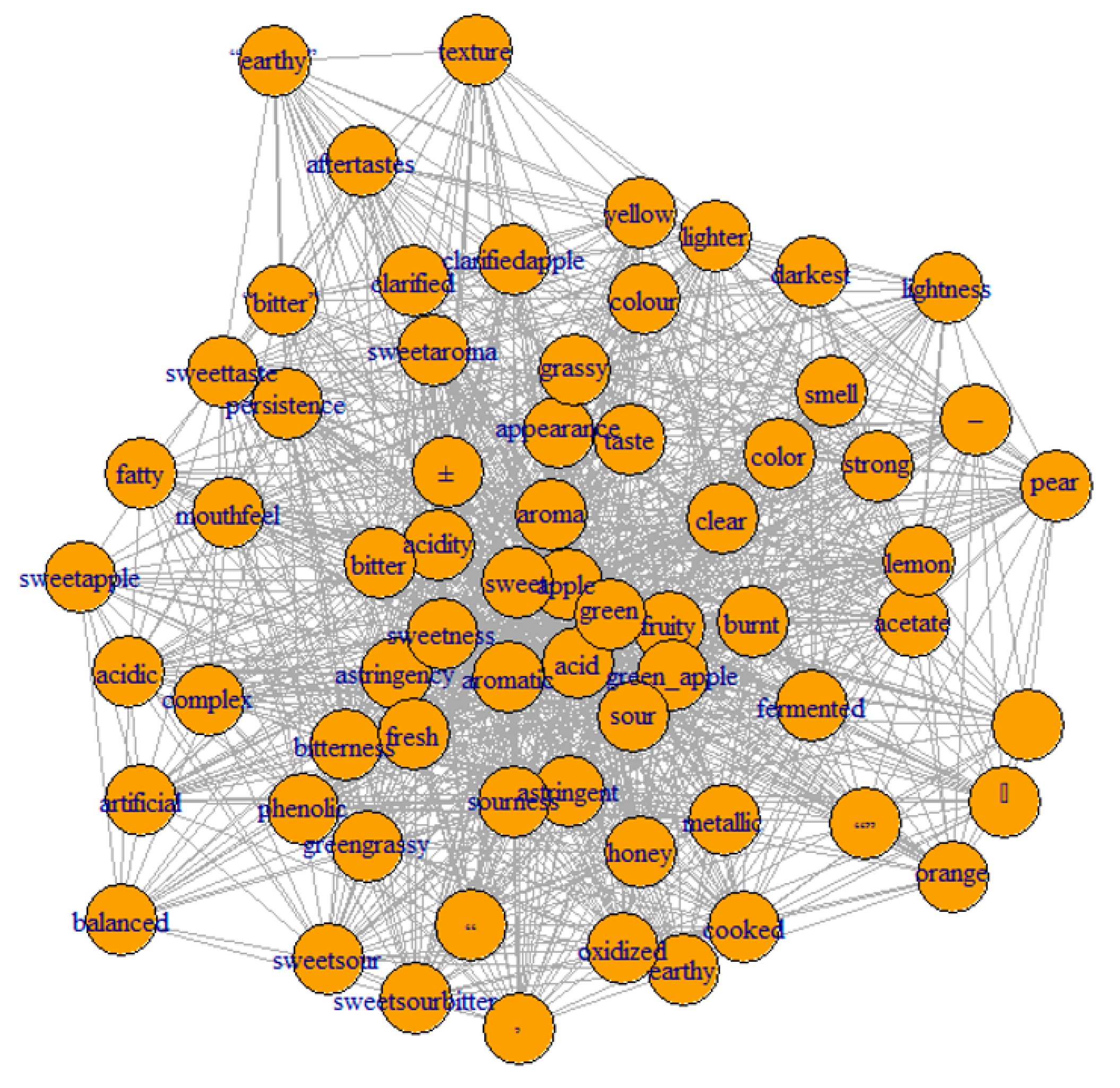
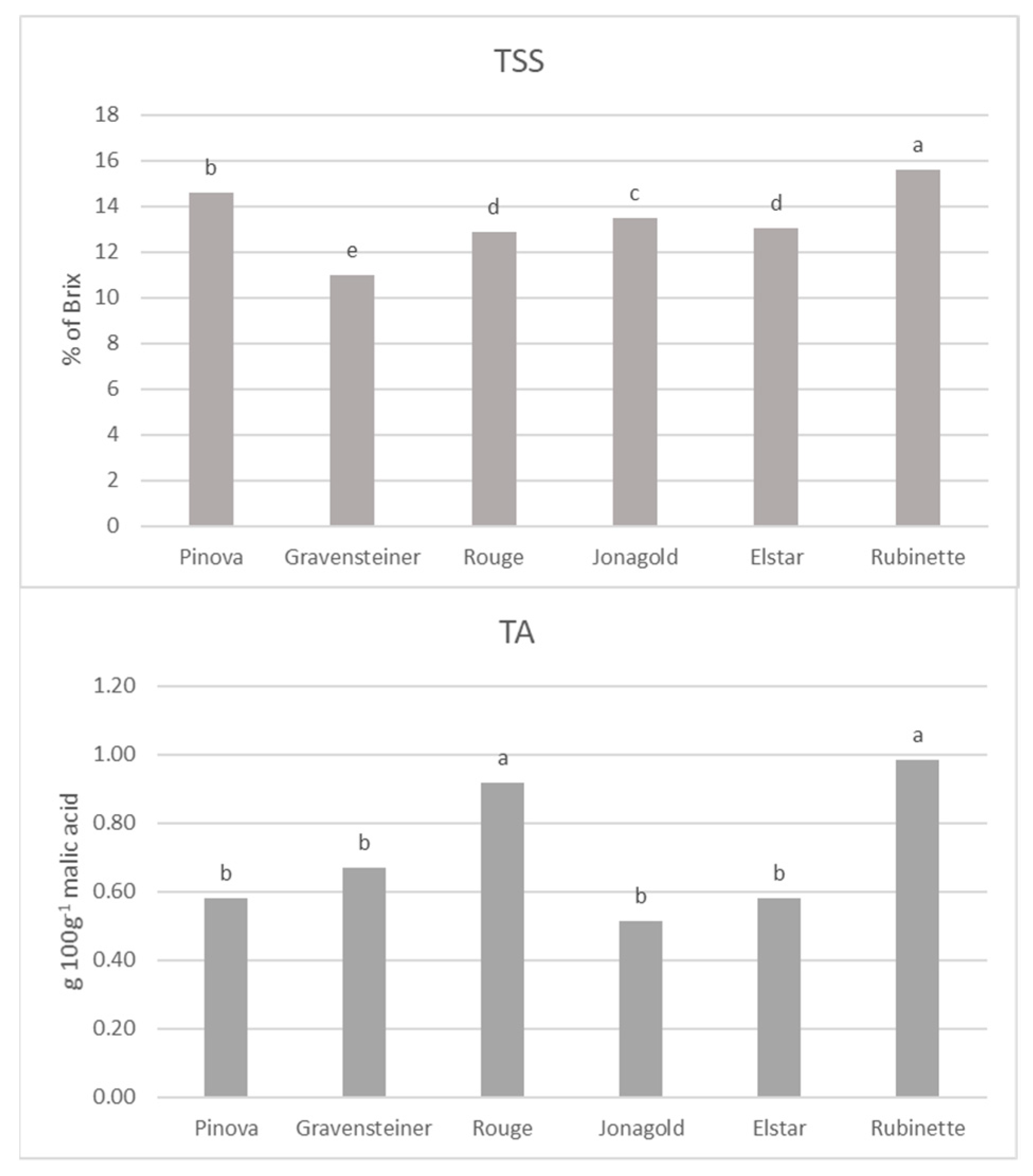
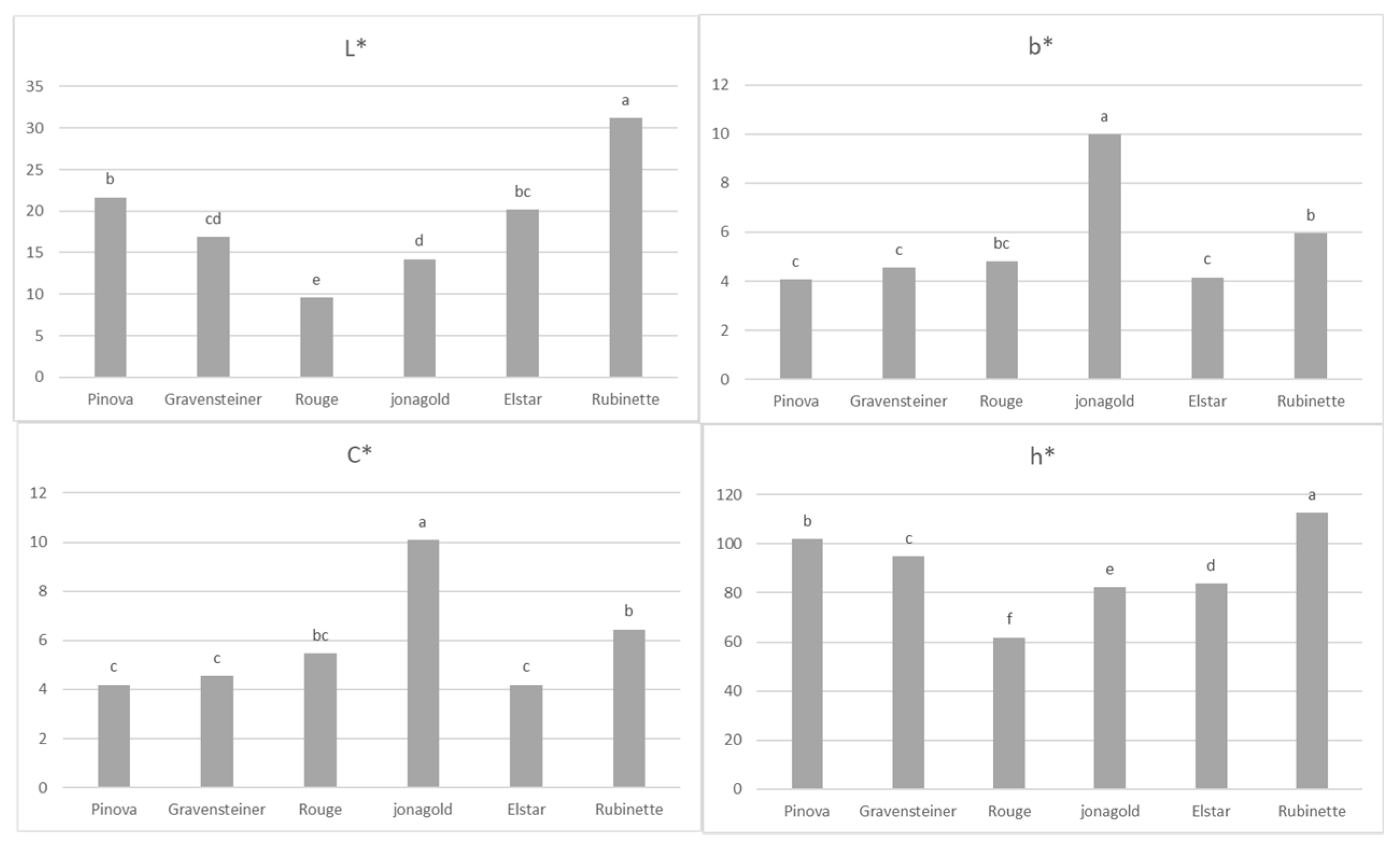

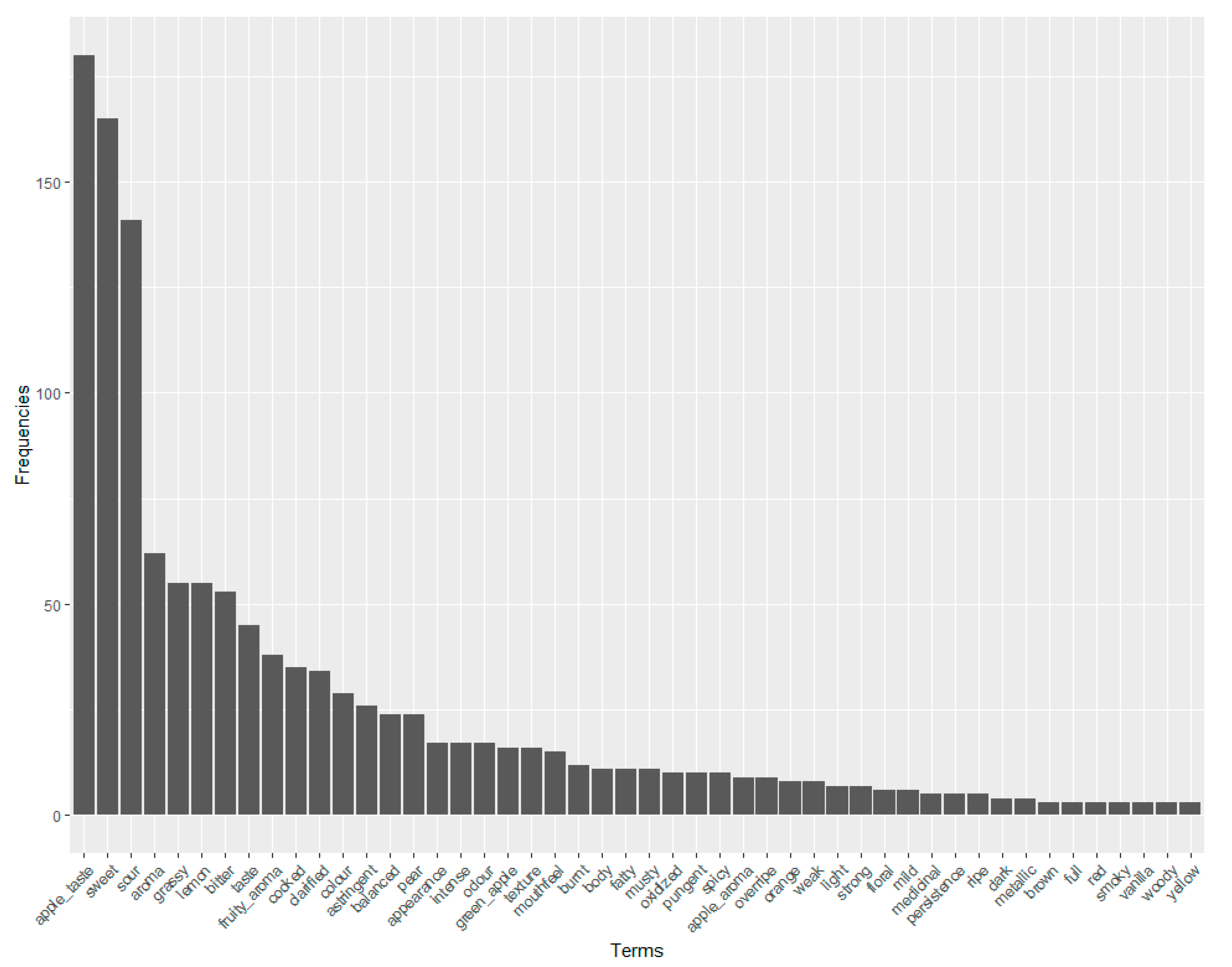


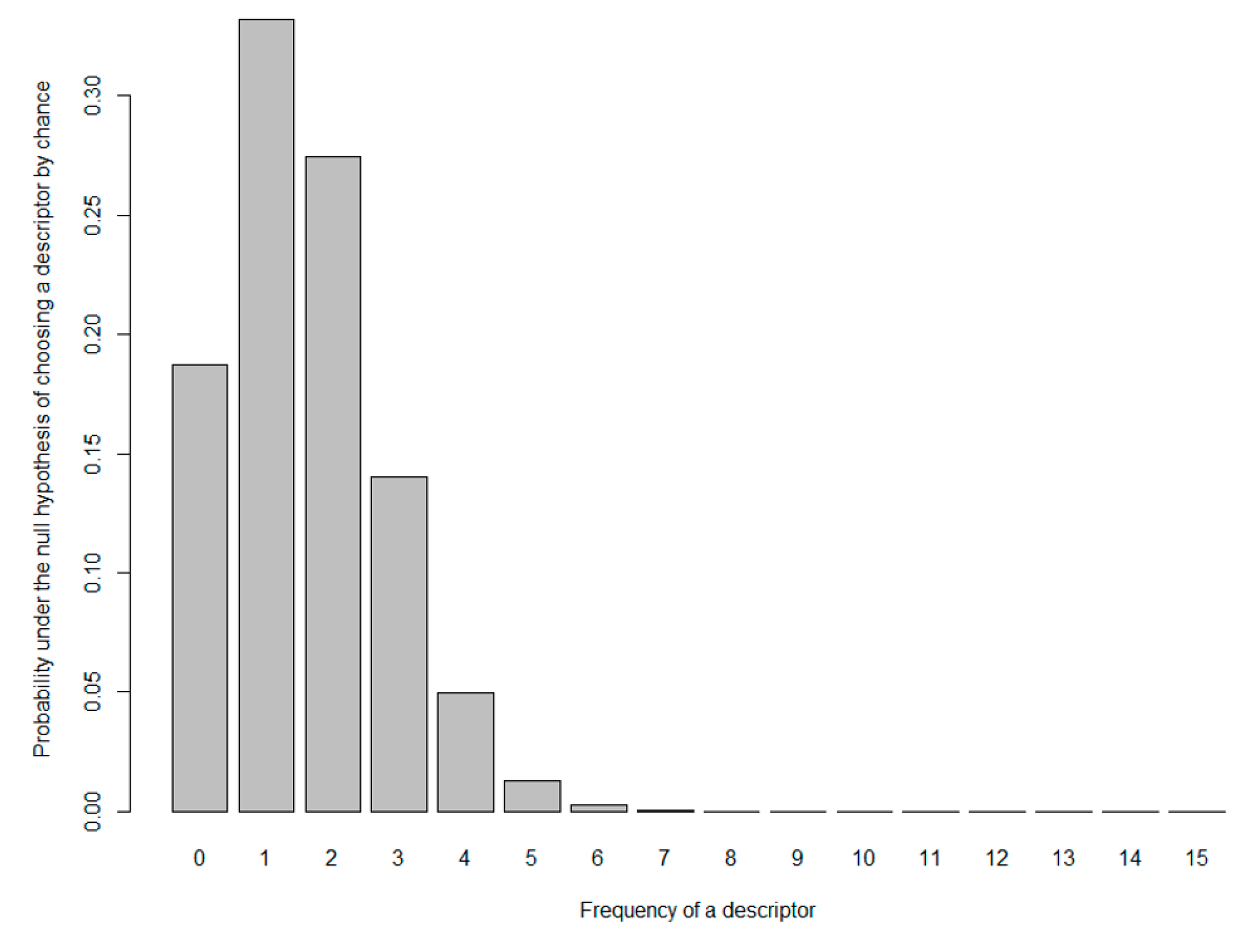
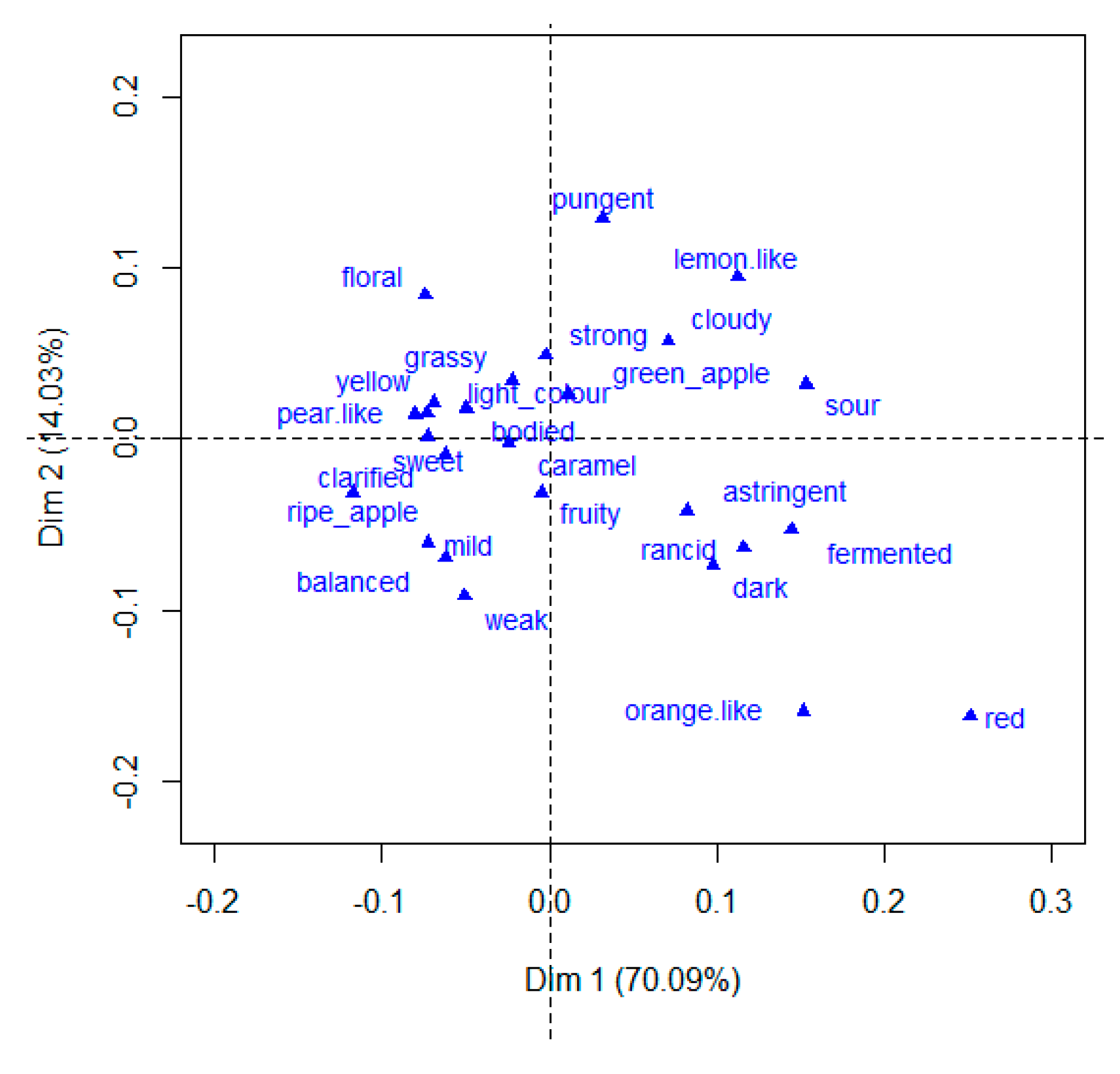
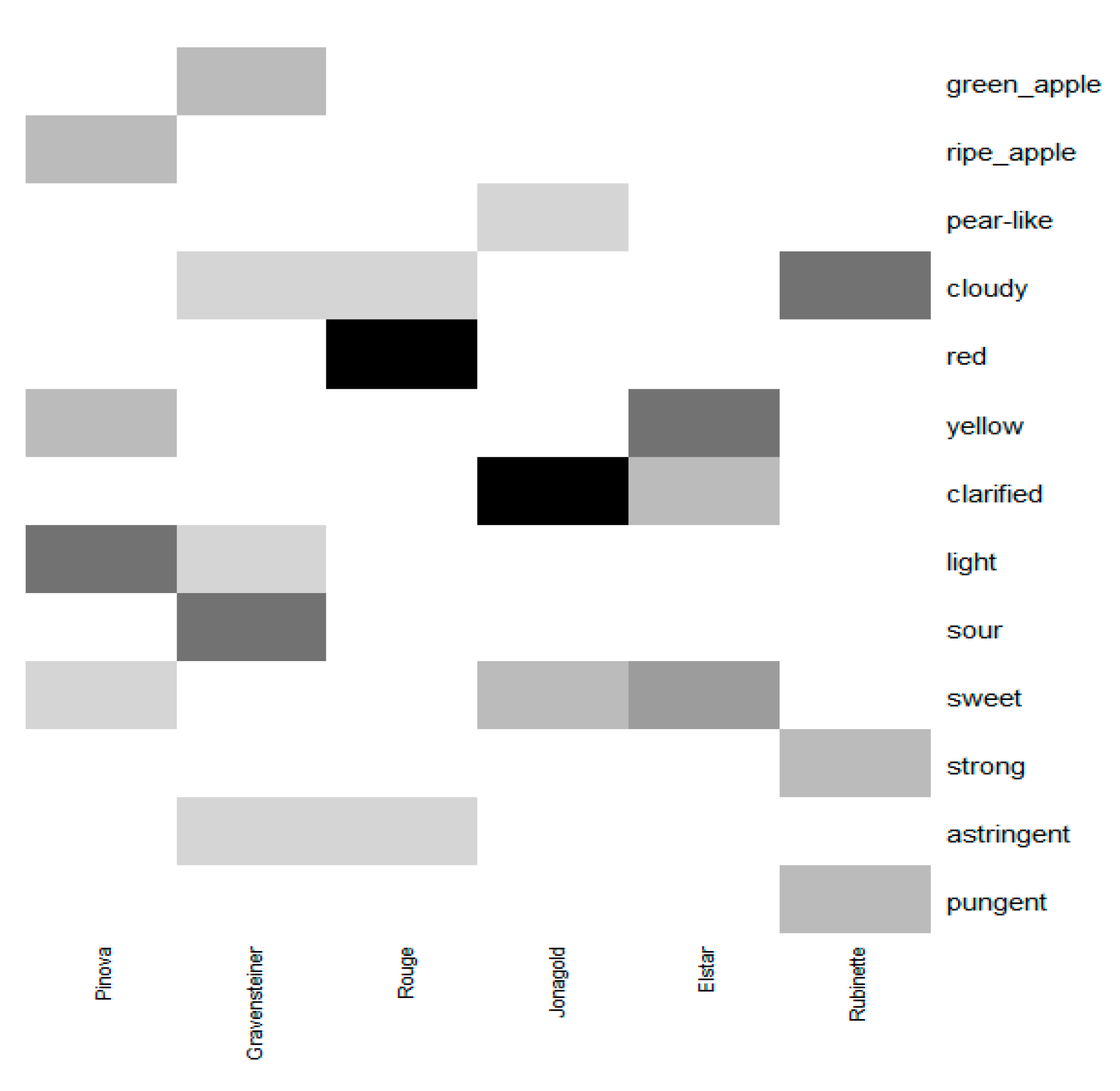
| Ratio TSS/TA | Rank | BrimA | Rank | |
|---|---|---|---|---|
| Pinova | 25.1 | 2 | 8.8 | 1 |
| Gravensteiner | 16.4 | 4 | 4.3 | 5 |
| Rouge | 14.1 | 6 | 3.7 | 6 |
| Jonagold | 26.2 | 1 | 8.3 | 2 |
| Elstar | 22.5 | 3 | 7.2 | 3 |
| Rubinette | 15.9 | 5 | 5.8 | 4 |
| Normalized Terms | |||
|---|---|---|---|
| Term | Similar Terms | Related Terms * | Frequency |
| sweet | sweeter | /** | 165 [2,5,14,15,16,17,18,20,21,22,23,24,25,26,27] |
| sweetness | / | ||
| sour | acid | / | 141 [2,5,14,15,16,18,20,21,22,23,24,26,27] |
| acidic | / | ||
| acidity | / | ||
| sourness | / | ||
| aroma | aromatic | / | 62 [2,5,14,15,16,20,22,24,25,26,27] |
| grassy | / | green | 55 [2,14,15,17,18,21,22,26,27] |
| / | phenolic | ||
| / | acetaldehyde | ||
| lemon | hexanal green | 55 [2,14,15,18,21,22,26,27] | |
| bitter | bitterness | artificial | 53 [5,14,16,18,20,21,22,23,24,27] |
| taste | tastes | 45 [14,15,16,20,22,24,26] | |
| cooked | / | candy | 35 [14,17,18,26,27] |
| / | caramel | ||
| / | honey | ||
| clarified | clear | / | 34 [5,14,20,22,24,27] |
| color | color | / | 29 [5,14,16,20,22,23] |
| astringent | astringency | / | 26 [14,15,18,20,21,22,27] |
| pear | pear-like | / | 24 [16,18,20,22,23] |
| balanced | / | complex | 24 [2,16,20,22,26,27] |
| / | sweet.sour sour.sweet | ||
| odor | odor | / | 17 [15,17,24,26,27] |
| smell | / | ||
| light | lightness | / | 7 [5,22,24,26] |
| floral | / | flowery | 6 [18,27] |
| dark | darkest | / | 4 [16,22] |
© 2019 by the authors. Licensee MDPI, Basel, Switzerland. This article is an open access article distributed under the terms and conditions of the Creative Commons Attribution (CC BY) license (http://creativecommons.org/licenses/by/4.0/).
Share and Cite
Mendes da Silva, T.; Torello Marinoni, D.; Peano, C.; Roberta Giuggioli, N. A New Sensory Approach Combined with a Text-Mining Tool to Create a Sensory Lexicon and Profile of Monovarietal Apple Juices. Foods 2019, 8, 608. https://doi.org/10.3390/foods8120608
Mendes da Silva T, Torello Marinoni D, Peano C, Roberta Giuggioli N. A New Sensory Approach Combined with a Text-Mining Tool to Create a Sensory Lexicon and Profile of Monovarietal Apple Juices. Foods. 2019; 8(12):608. https://doi.org/10.3390/foods8120608
Chicago/Turabian StyleMendes da Silva, Thais, Daniela Torello Marinoni, Cristiana Peano, and Nicole Roberta Giuggioli. 2019. "A New Sensory Approach Combined with a Text-Mining Tool to Create a Sensory Lexicon and Profile of Monovarietal Apple Juices" Foods 8, no. 12: 608. https://doi.org/10.3390/foods8120608
APA StyleMendes da Silva, T., Torello Marinoni, D., Peano, C., & Roberta Giuggioli, N. (2019). A New Sensory Approach Combined with a Text-Mining Tool to Create a Sensory Lexicon and Profile of Monovarietal Apple Juices. Foods, 8(12), 608. https://doi.org/10.3390/foods8120608







